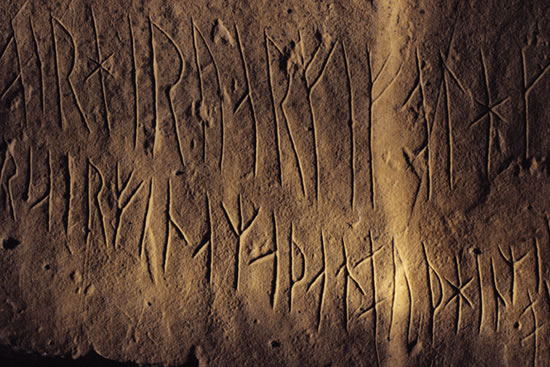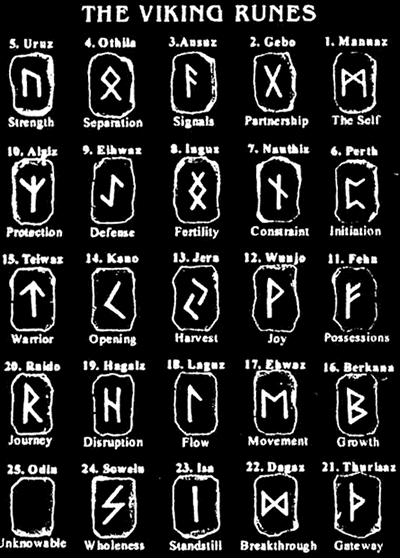|
|
|||
 |
|||
|
TATTOO DESIGNS & SYMBOLS - VIKING RUNE TATTOOS
Tattoo Symbol Index - A B C D E F G H I J K L M N O P Q R S T U V W X Y Z Tattoo designs - V >> Viking Runes The Vikings carved runes most often on rocks, inscriptions that hinted at heroic exploits and famous people. Runes eventually came into use as a sigle (?) to cast spells, and as an oracular device to consult about matters both public and personal. The use of runes ended in the Middle Ages when the medieval church outlawed them in an effort to stamp out paganism and to ‘drive the devil out of Europe’. The current popularity of runes as a form of tattoo script, however, is due to precisely those outlawed occult activities – as a medium of divination and magic. However sincerely we play with the ancient runes, we should be aware that very little is actually known about them.
The runic alphabet is called ‘futhark’, and takes its name from the first six letters of the runic sequence – fehu, uruz, thurisaz, ansuz, raido, and kenaz. While most alphabets employ letters that are meaningless beyond the phonetic sound they represent, each rune is a word that may also have a special meaning associated with Norse mythology. Fehu, for example, means ‘cattle’. The futhark originally consisted of 24 letters (the Elder Futhark), but was reduced to 16 characters. This unorthodox alphabet was eventually displaced in Europe by the Roman alphabets, yet the runes survived in manuscripts and as inscriptions in stone, wood, horn, and metal. When did the runes first come into use? And where did they come from? There are no definitive answers, although the earliest found runes date back to the second and third centuries A.D. That the runes grew from some previous alphabet is generally agreed, but from which one? From Latin, Greek, or the Etruscan alphabet. Even the Gokturks, the first Turks, wrote their language in a runic script. Pre-runic symbols have been found in Bronze Age rock carvings. But Scandinavians speak of their runes as gifts from their chief god, Odin. With such a divine origin, it’s no wonder that Nordic peoples have so revered the runes, and attributed to them magical powers.
With such a strong belief in supernatural powers, the Vikings left it to a Rune Master to negotiate the talismanic properties of their alphabet. Power is believed to infuse the arrangement of lines of a single rune. Consulting the runes for guidance was an art not taken lightly. “Let no man carve runes to cast a spell,” said a Viking poet, “save first he learns to read them well.” Viking legends speak of illness and health, and of luck and disaster that flow from the right or wrong runic combinations or spellings. For this reason, spiritualists would warn against willy-nilly taking on a runic tattoo. Or is blind belief enough? Viking warriors, for instance, inscribed their swords with runic inscriptions that appealed to the gods for protection. The special ‘berserker’ squads clothed in wolf or bear skins waged war with the runic symbol for ‘Tyr’ (their god of war) carved onto their shields. The rune bolstered their courage and sense of invulnerability to the point of uncontrollable fury. They went ‘berserk’. When the Vikings voyaged across the seas, they naturally took their system of writing with them, leaving runic inscriptions on everything from stone monoliths to household tools. Large freestanding rocks called runestones were often raised as memorials to the dead. These were inscribed with both religious and practical information. Runes adorned coins, coffins, swords, and gravestones, as well as roughly 3500 stone monuments, mainly in Sweden and Norway. Some of the best inscriptions comprise a list of the entire runic alphabet. ‘Rune poems’ from the 9th to the 12th centuries A.D. explain the runes one by one, a verse dedicated to each rune. But any knowledge that Rune Masters might have had has long vanished in the mists of time. The modern-day rune revival owes much of its success to apocryphal nonsense dispensed by self-awareness gurus. While we entertain ourselves with the runes -- even tattooing them on our bodies -- it should be remembered that they emerged from a society fundamentally different from our own. While we may deploy them for purposes of protection, personal therapy, and fortune telling, the most conscientious among us will not lose sight of the fact that they reflect the ancient Norse world-view.The interpretations of the runes we read about in New Age books are unlikely to resemble the true and original meanings of the runes.
The 24 characters of the Elder Futhark: Fehu Tattoo designs - V >> Viking Runes Tattoo Symbol Index - A B C D E F G H I J K L M N O P Q R S T U V W X Y Z |
||
| Celeb Tattoos | Facts & Stats | Designs & Symbols | History | Culture | Links | Tattoo Galleries | Contact | |||
|
|
|||




 A thorough understanding of the myths, culture and lifestyle of the ancient peoples of northern Europe is vital to a complete understanding of the runes.
A thorough understanding of the myths, culture and lifestyle of the ancient peoples of northern Europe is vital to a complete understanding of the runes.